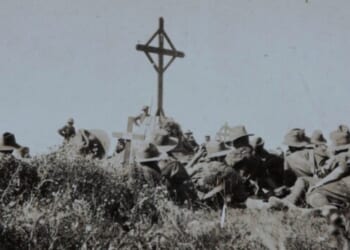While the A-36 proved capable of consistently hitting its targets, the aircraft’s accident rate was concerning.
Did you know that a ground-attack/dive-bomber version of the P-51 Mustang was made during World War II? It’s true. The A-36, sometimes referred to as the “Apache” (not to be confused with the later attack helicopter) or “Invader,” was essentially a P-51 outfitted with dive brakes situated above and below the wings.
500 A-36s were built, mostly during 1942, and mostly as a stopgap to keep North American Aviation’s assembly lines running at a time when the U.S.’s fighter aircraft budget had been exhausted. But the A-36, like its progeny, the famed P-51 Mustang, proved to be an adept aircraft that ultimately made a meaningful contribution to the Allied war effort.
Why Did the Air Force Need a Dive Bomber?
Dive bombing is a tactic in which an aircraft dives steeply, typically at an angle of 60 degrees or more, towards a target to drop a bomb. The dive trajectory allows for greater accuracy—which is especially helpful against smaller, or moving, targets like a bridge or a ship.
The A-36 was designed to take on a dive-bomb (and ground-attack) role. Accordingly, it was outfitted with .50-caliber machine guns in the nose and along the wings. Notably, the A-36 was outfitted with dive brakes, to help arrest the high-velocity descents required of the dive bombing tactic. And because there was little reason for the A-36 to fly at higher altitudes, as the P-51 Mustang would, the aircraft was installed with a more limited Allison V-1710-87 engine with 1,325 horsepower at 3,000 feet—which was adequate for low-altitude operations, but underwhelming at higher altitudes. The engine’s air inlet was modified from the P-51 to feature a fixed unit with a larger opener, as opposed to the earlier version that could be lowered into the airstream. Also, envisioning operations in hostile climes, the A-36 was outfitted with a tropical air filter capable of shielding the engine from the sand and grit that one may encounter in, say, Northern Africa.
The A-36 Went to War—and Mostly Didn’t Come Back
Indeed, the A-36 participated in combat during the North African campaign, and soon moved onto other theaters, including the Mediterranean, European, and Indo-Pacific. The new P-51-variant quickly proved to be a capable weapon; pilots would initiate their vertical dives at 12,000-feet, with the dive brakes deployed to limit speeds to just 390 miles per hour. Bombs were typically released between 2,000 and 4,000 feet. Immediately thereafter, the pilots would enter a sharp pull-up maneuver to avoid crashing into the ground below.
Yet while the A-36 proved capable of consistently hitting its targets, the aircraft’s accident rate was concerning. In one notable incident, an A-36’s two wings were sheared off during a post-dive pull up. Some A-36 units restricted their pilots from diving at angles greater than 70 degrees. And, in response to problems with the dive brake’s hydraulic actuators, which sometimes deployed the brakes unevenly on each side—resulting in an aileron-like roll—some units advised against using the dive brakes. In one instance, they even wired them shut!
In part because of these problems, the A-36 is an extremely rare bird today. Only two are known to still be airworthy. And just one remains on display, the Margie H, which can be found at the National Museum of the United States Air Force at Wright-Patterson ADB in Dayton, Ohio.
About the Author: Harrison Kass
Harrison Kass is a senior defense and national security writer with over 1,000 total pieces on issues involving global affairs. An attorney, pilot, guitarist, and minor pro hockey player, Harrison joined the U.S. Air Force as a Pilot Trainee but was medically discharged. Harrison holds a BA from Lake Forest College, a JD from the University of Oregon, and an MA from New York University. Harrison listens to Dokken.
Image: Wikimedia Commons.















